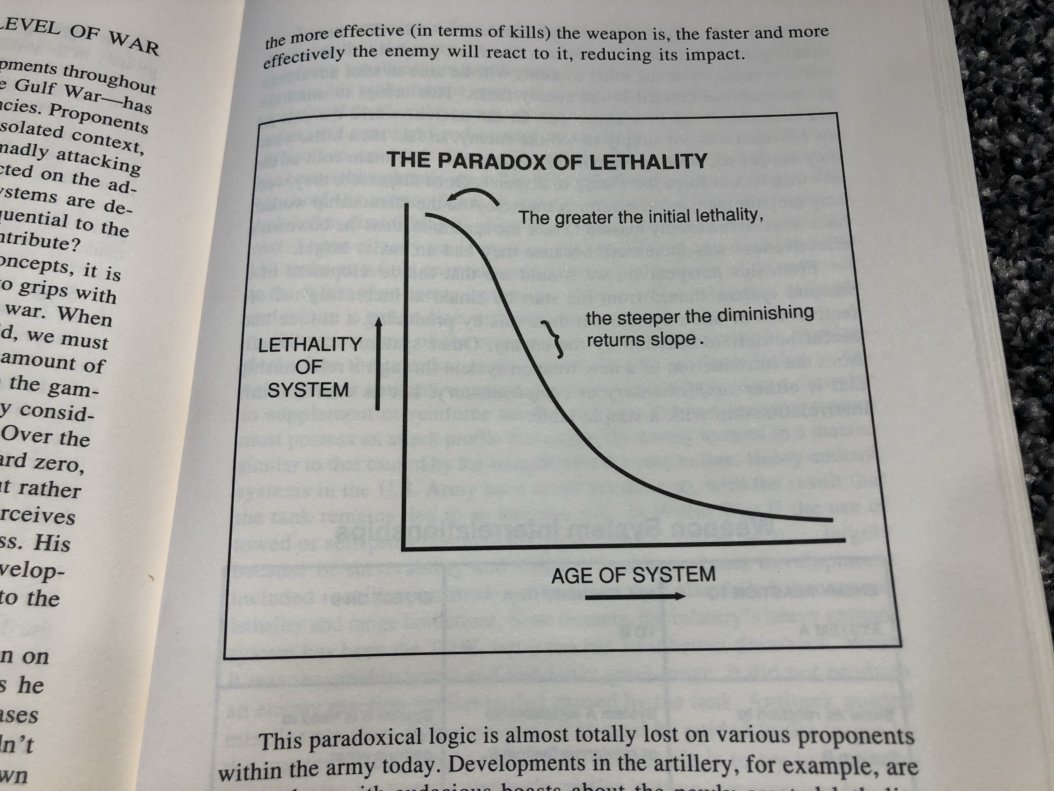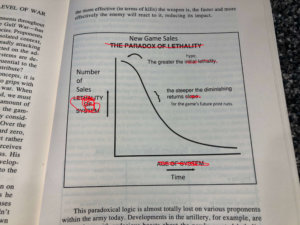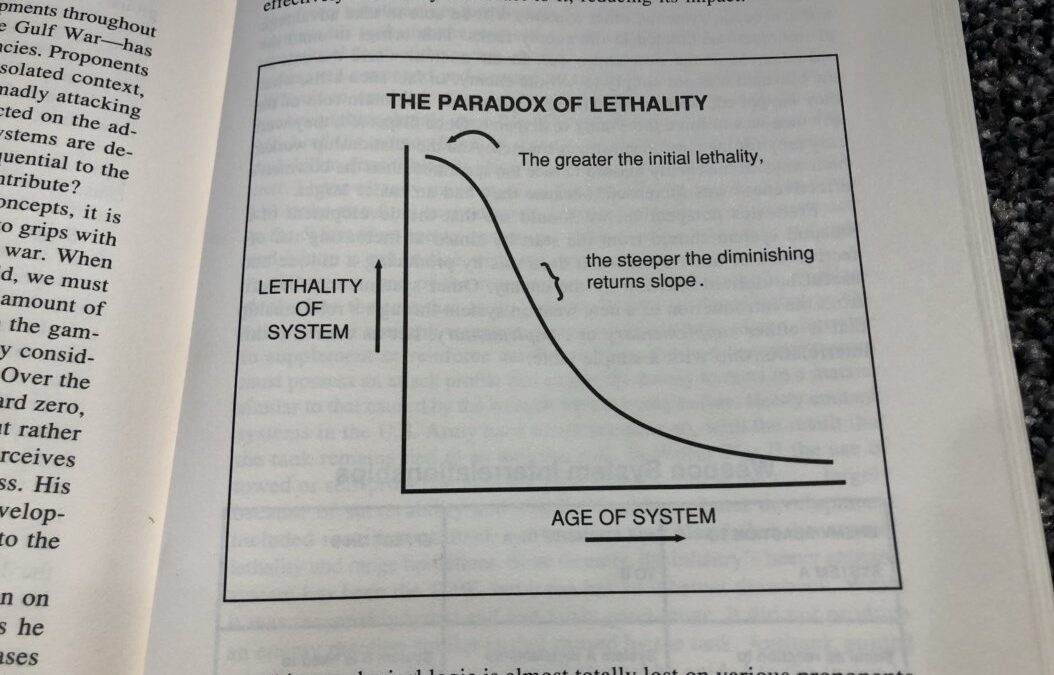You must be a Prophet of Profit
In the last post, I discussed the breakdown of costs and the general rules for setting a game’s price. This time I’ll dive more into how the print run size effects all this – especially when you’re not able to afford to pre-print everything like Monolith shrewdly has!
Game Sales Dramatically Diminish Over Time
The first, and most important thing to keep in mind, is the general nature of board game product sales. The first print run is almost always going to be the biggest, and you’ll experience the most sales in the first months following release. Sales will naturally diminish over time. While there are certainly exceptions, such as “evergreen” products like Settlers of Catan and Ticket to Ride, which sell fairly consistently year to year, as well as sleeper hits whose popularity can grow over time, most games get one real chance to make an impact, and then they’re gone.
In Robert Leonhard’s enlightening book, The Art of Maneuver, he describes a similar phenomenon in the lethality of weapon systems employed by militaries. For our purposes, I’m really just using this to show the graph:

Most know that my Dad, Sandy, is an immense Lovecraft and horror fan; what some may not know is that he devours military history like popcorn as well and can literally discuss even obscure historical military matters for hours. I’ve been cursed with this appetite as well, and indeed we are in the midst of an email discussion (with my grandfather as well) regarding the distinctions between the characteristics of air superiority vs air supremacy this week!
Here’s the real graph I would make if I had even the teensiest graphical ability in me:

You may note that this is in stark contrast to my statement in the previous post that our plan for The Gods War is that we intend for its profitability to be established over time. Also, this is in opposition to Monolith’s stated expectation that Claustrophobia will not initially be profitable, but will be so with future print runs and sales. There are a few explanations which combine to explain the phenomenon in total.
It’s all about the mix of products
First, if there were a way to have the initial game profitable from the outset, we would certainly elect to do that (as would Monolith, no doubt). While the ultimate decision to set the price of the product is up to the publisher, there are many constraints we have little or no control over. Publishers don’t get to decide the costs our factories charge (who are themselves constrained by their suppliers and the cost of labor), nor can we determine the demand dictated by consumers (who are constrained and influenced by various factors – publishers can influence via marketing – but there are many others we can’t affect). Other costs such as what freelance artists and sculptors charge, while negotiable, are likewise subject to constraints on both sides. The point is that there is going to be a range a given product can realistically be priced at, but that price range isn’t magically one that guarantees profitability! If costs and demand force a game into a price that isn’t profitable, that’s just how it is. The fact is, not all individual products lead to profits.
Hence the subtitle of my post – you need to accurately prophecy that all the time, effort, and investment you put into a product will lead to true profits. It isn’t guaranteed to do so, even when a Kickstarter is funded many times more than the funding goal. As we’ve seen in the previous post, the price a publisher sets for the game can make a dramatic difference as to whether it makes a profit or not. And as we see above, the price a publisher sets is constrained by many factors outside its control.
Obviously, the sum total of a publisher’s products need to make money for the publisher to continue as a business entity. An individual product can fail, so long as there are other sources of profitability. This is one of the reasons it’s so hard to make money on Kickstarter, or as a small publisher (or small business in general). Profits from a single product can be a real gamble; but if you can make LOTS of products, then their aggregate can lead to success. So long as a publisher can juggle its cash flow properly (i.e, paying for overhead and the costs of goods sold as they come due), then it can continue until profits emerge. Sandy, the sole owner of Petersen Games, pays himself a salary (which is considered part of the company overhead), since this is his full time job, but he doesn’t have profits beyond that as a source of income – yet. This is why we are still a Kickstarter based company – we don’t have spare capital to make anything but very small games without up front cash. This is very typical for small, young companies. It is not destiny, it is because we are still very much an “indie” company.
We do believe The Gods War has plenty of potential profits to reap down the road. “Blockbuster” style games – big box, big miniature, epic, expensive games – have somewhat of an advantage over the typical board game. If they can capture some element of the current gaming zeitgeist (like Zombicide, Kingdom Death: Monster, and to a lesser extent Cthulhu Wars have done in recent years), then they experience some level of sustained sales. Note, however, that in all three of these Kickstarter game examples, the publishers have elected to offer new versions (Zombicide and KD:M), or lots of expansions (CW). The actual initial products have generally still experienced diminishing sales – Zombicide may be evergreen, but I’d bet that newer editions have dramatically outsold reprints of the first edition in recent years. In other words, these initial products become entire game lines such that they are like a microcosm of the business as a whole. Just as single products may lose money, but the business continues due to other products, so can core games, or initial releases of a major game lose money, but set the product line up for profitability over time as new versions and expansions are released. We hope that The Gods War will become a profitable product line over all, the way Cthulhu Wars has (again, the first Cthulhu Wars Kickstarter did not end up making money).

Super totally unrelated ( 😉 ), but check out our new Cthulhu Wars novel we released on Amazon, here.
What about non-blockbuster style games?
Ok, so what if we’re not talking about a game that is going to initiate a full product line, like Cthulhu Wars and The Gods War? What about things like Startropolis, Theomachy, and Dicenstein?
The hope is that single games are profitable from the outset. If they aren’t, then they likely won’t ever be profitable, due to the law of diminishing sales for board game products. Hopefully you don’t have too many of those, as a publisher, or else you’ll eventually go out of business. There’s not really another way to say it.
Setting the first Print Run Size
Since the initial print run is going to be the largest, and experience the most sales, the desire is often to make it be as big as possible. After all, if you order more, you’ll get price breaks from your supplier. But printing more of a game doesn’t automatically generate more demand, obviously. We’ve all seen which albums you see in every bargain bin. No one should ever pay more than like $2 for a pop album. I always buy my Katy Perry CDs after it’s been out for two years 😉
So, how do you determine demand? This is one of the (many) great blessings of crowdfunding platforms. The Kickstarter campaign itself tells you lots of things (not everything) about the demand for your game. Here lies another rough rule of thumb – that you take your Kickstarter backer quantity, and then overprint in a range of 50% to 100% more. In other words, never more than double the Kickstarter backer size.
We learned this the hard way. Theomachy was an unexpected success for us in early 2015. It was a card game (with great art!), designed by Historical Games Factory in Poland, and translated to English (with Cthulhu elements added in conjunction with Sandy for the English language version). It didn’t really have any right to make more than $100,000 on Kickstarter, but it did. And because it was so successful, we planned on printing exactly double (100%) more than the KS backers – around 2000 units total (KS ended up with just shy of 1000 backers). But our printers gave us a quote with such a nice price break at 4000 units! We knew printing 300% more was crazy. So, we negotiated with them and said we would be willing to go up to 3000 units of each Theomachy core game, if they would give us the 4000 per unit price, but for only 3000 units. And guess what? They did! So, to “save” money, we printed 200% more than our Kickstarter backers – twice as much as what the highest rule of thumb dictates. Like with all “savings” deals, if you didn’t really plan on buying the thing anyway, you aren’t actually saving anything. In a real sense, you can never save money by spending money. As predicted by the rule of thumb that says you shouldn’t print more than 100% your backers, we still have units of Theomachy in our warehouse from the first and only print run. Granted, it’s still as good a game as it ever was – and we do still sell it a little here and there, and yes, we’re down to several hundred left, which means we’ve actually sold far more than only 100% more than the KS backers. However, it would have been wiser to spend less back in 2015, to make a smaller print run, and to therefore have zero stock of Theomachy right now. Every month it sits on its pallets in our warehouse we have pay for the space (it’s not much, but it’s still an expense we wish didn’t exist). Did I mention it’s a really good game, though? 😉
Contrast this with Dicenstein – which was Kickstarter the same year, but for which we set the print run after Theomachy hit the market and we experienced first hand how quickly the sales start to drop off. The Dicenstein Kickstarter ended up with a little more than 600 units sold. Since 1000 units is often the minimum quantity you should ever consider, we made that our print run (about 66% more than the KS backers, in the middle of the rule of thumb). That was the right decision. It sold best shortly after release (as predicted), but then sales dropped. Since we really had slightly fewer than 400 to sell (the 600+ for KS backers), it still worked out, and we are very close to having no copies left. Because I personally love the game – and think it could still sell – I am pushing for a small reprint sometime next year. But it’s not guaranteed, because the minimum we’d want to do is likely 1000 units, and we know it will almost certainly not sell as many as the first round. The designer is working on a way to use fewer dice so the price can come down – so we’ll have to see. Remember, different editions can work out!
Back to a big game – Cthulhu Wars – for a moment. Because Cthulhu Wars is so costly to make, and it has many expansions (which each tend to cost as much as an average “core game,” rather than a much cheaper expansion), we tend to never be able to meet demand at all. This is the opposite problem. There is always more demand than we can supply, given our limited funds. This is a separate challenge, I may address in a future post.
Next time I’ll talk about the board game industry value chain and where the publisher sits.
Comments, questions, concerns all welcome! Post a comment below.
– Arthur

